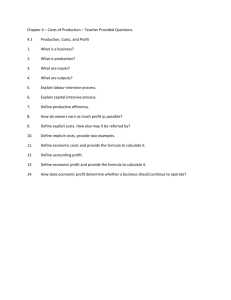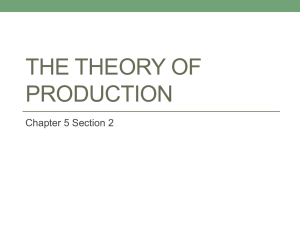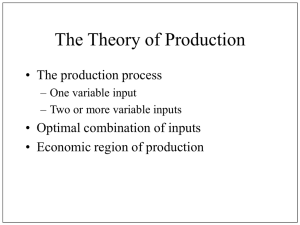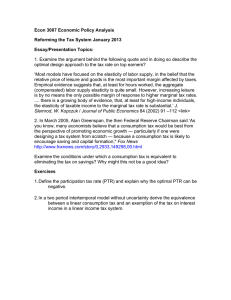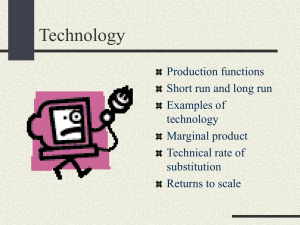Pertemuan < 7 > Production Economics Chapter 7 Matakuliah
advertisement
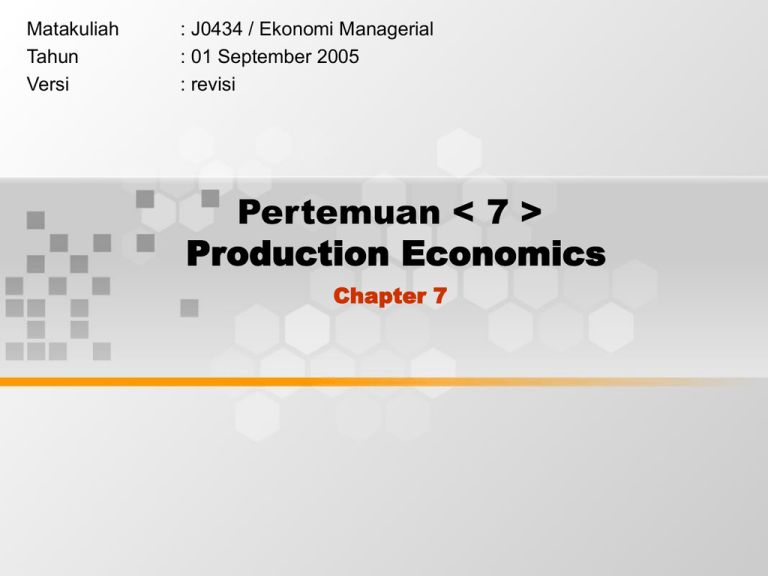
Matakuliah
Tahun
Versi
: J0434 / Ekonomi Managerial
: 01 September 2005
: revisi
Pertemuan < 7 >
Production Economics
Chapter 7
Learning Outcomes
Pada akhir pertemuan ini, diharapkan mahasiswa
akan mampu :
menerangkan konsep produksi dan biaya (C2).
Outline Materi
•
•
•
•
Production Economics
Production Economics: In the Short Run
Long Run Production Functions
Economies of Scale
Production Economics
• Managers must decide not only what to produce for the
market, but also how to produce it in the most efficient or
least cost manner.
• Economics offers a widely accepted tool for judging
whether or not the production choices are least cost.
• A production function relates the most that can be
produced from a given set of inputs. This allows the
manager to measure the marginal product of each input.
2002 South-Western Publishing
1. Production Economics: In the Short Run
• Short Run Production Functions:
– Max output, from a n y set of inputs
– Q = f ( X1, X2, X3, X4,
FIXED IN SR
... )
VARIABLE IN SR
_
Q=
Fixed
f ( K, L) for two input case, where K as
Production Economics: In the Short Run
• Average Product = Q / L
– output per labor
• Marginal Product =Q / L = dQ / dL
– output attributable to last unit of labor applied
• Similar to profit functions, the Peak of MP
occurs before the Peak of average product
• When MP = AP, we’re at the peak of the AP
curve
Production Elasticities
• The production elasticity for any input, X, EX =
MPX / APX = (DQ/DX) / (Q/X) = (DQ/DX)·(X/Q),
which is identical in form to other elasticities.
• When MPL > APL, then the labor elasticity, EL > 1.
A 1 percent increase in labor will increase output by
more than 1 percent.
• When MPL < APL, then the labor elasticity, EL < 1.
A 1 percent increase in labor will increase output by
less than 1 percent.
Short Run Production Function
Numerical Example
L
0
1
2
3
4
5
Q
0
20
46
70
92
110
MP
--20
26
24
22
18
Marginal Product
AP
--20
23
23.33
23
22
Labor Elasticity is greater then one,
for labor use up through L = 3 units
Average
Product
1
2
3
4
5
L
Short Run Production Function
Numerical Example
• When MP > AP, then AP is RISING
– IF YOUR MARGINAL GRADE IN THIS CLASS IS
HIGHER THAN YOUR AVERAGE GRADE POINT
AVERAGE, THEN YOUR G.P.A. IS RISING
• When MP < AP, then AP is FALLING
– IF THE MARGINAL WEIGHT ADDED TO A TEAM IS
LESS THAN THE AVERAGE WEIGHT, THEN
AVERAGE TEAM WEIGHT DECLINES
• When MP = AP, then AP is at its MAX
– IF THE NEW HIRE IS JUST AS EFFICIENT AS THE
AVERAGE EMPLOYEE, THEN AVERAGE
PRODUCTIVITY DOESN’T CHANGE
Law of Diminishing Returns
INCREASES IN ONE FACTOR OF PRODUCTION,
HOLDING ONE OR OTHER FACTORS FIXED,
AFTER SOME POINT,
MARGINAL PRODUCT DIMINISHES.
MP
A SHORT
RUN LAW
point of
diminishing
returns
Variable input
Three stages of production
• Stage 1: average
product rising.
• Stage 2: average
product declining (but
marginal product
positive).
• Stage 3: marginal
product is negative, or
total product is
declining.
Total Output
Stage 2
Stage
1
Stage 3
L
Optimal Employment of a Factor
• HIRE, IF GET
MRP L MP L • P Q = W
MORE REVENUE
THAN COST
• HIRE if
wage
DTR/DL > DTC/DL
• HIRE if
MRP L > MFC L
•
W
W
• AT OPTIMUM,
MRP L = W
MRP
MP L
L
optimal labor
MRP
L
is the Demand for Labor
• If Labor is MORE
productive, demand
for labor increases
• If Labor is LESS
productive, demand
for labor decreases
• Suppose an
EARTHQUAKE destroys
capital
• MP L declines with
less capital, wages
and labor are HURT
SL
W
DL
D’ L
L’ L
2. Long Run Production Functions
• All inputs are variable
– greatest output from any set of inputs
• Q = f( K, L ) is two input example
• MP of capital and MP of labor are the
derivatives of the production function
– MPL = Q /L = DQ / DL
• MP of labor declines as more labor is applied.
Also MP of capital declines as more capital is
applied.
Homogeneous Functions of Degree n
• A function is homogeneous of degree-n
– if multiplying all inputs by , increases the
dependent variable byn
– Q = f ( K, L)
– So, f(K, L) = n • Q
• Homogenous of degree 1 is CRS.
• Cobb-Douglas Production Functions are
homogeneous of degree +
Cobb-Douglas Production
• Q = A • K • L is a Cobb-Douglas
Production Function
• IMPLIES:
– Can be IRS, DRS or CRS:
if + 1, then CRS
if + < 1, then DRS
if + > 1, then IRS
• Coefficients are elasticities
is the capital elasticity of output
is the labor elasticity of output,
which are EK and E L
Isoquants & LR Production
• In the LONG RUN,
ALL factors are
variable
• Q = f ( K, L )
• ISOQUANTS -- locus
of input combinations
which produces the
same output
• SLOPE of
ISOQUANT is ratio of
Marginal Products
ISOQUANT MAP
K
Q3
B
C
A
Q2
Q1
L
Optimal Input Combinations
in the Long Run
• The Objective is to
• Equimarginal Criterion
Minimize Cost for a
Produce where
given Output
MPX/CX =
MPY/CY where
• ISOCOST lines are the
combination of inputs for
a given cost
• C0 = CX·X + CY·Y
• Y = C0/CY - (CX/CY)·X Y
marginal products per
dollar are equal
E
at E, slope of
isocost = slope
of isoquant
Q1
X
Use of the Efficiency Criterion
• Is the following firm
EFFICIENT?
• Suppose that:
–
–
–
–
MP L = 30
MP K = 50
W = 10 (cost of labor)
R = 25 (cost of capital)
• Labor: 30/10 = 3
• Capital: 50/25 = 2
• A dollar spent on labor
produces 3, and a dollar
spent on capital produces
2.
• USE RELATIVELY MORE
LABOR
• If spend $1 less in capital,
output falls 2 units, but
rises 3 units when spent
on labor
What Went Wrong With
Large-Scale Electrical Generating Plants?
• Large electrical plants had cost
advantages in the 1970s and 1980s
because of economies of scale
• Competition and purchased power
led to an era of deregulation
• Less capital-intensive
generating plants appear
now to be cheapest
Economies of Scale
• CONSTANT RETURNS TO SCALE (CRS)
– doubling of all inputs doubles output
• INCREASING RETURNS TO SCALE (IRS)
– doubling of all inputs MORE than doubles output
• DECREASING RETURNS TO SCALE
(DRS)
– doubling of all inputs DOESN’T QUITE double output
Increasing Returns to Scale
• Specialization in the use of capital and labor.
Labor becomes more skilled at tasks, or the
equipment is more specialized, less "a jack of
all trades," as scale increases.
• Other advantages include: avoid inherent
lumpiness in the size of equipment, quantity
discounts, technical efficiencies in building
larger volume equipment.
DECREASING RETURNS TO SCALE
• Problems of coordination and control as it is
hard to send and receive information as the scale
rises.
• Other disadvantages of large size:
– slow decision ladder
– inflexibility
– capacity limitations on entrepreneurial skills
(there are diminishing returns to the C.E.O.
which cannot be completely delegated).
Economies of Scope
• FOR MULTI-PRODUCT FIRMS,
COMPLEMENTARY IN PRODUCTION MAY
CREATE SYNERGIES
– especially common in Vertical Integration of firms
• TC( Q 1 + Q 2) < TC (Q 1 ) + TC (Q 2 )
=
+
Chemical
firm
Petroleum
Cost
Efficiencies
Electrical Generating Capacity
• A cross section of 20 electrical utilities (standard
errors in parentheses):
• Ln Q = -1.54 + .53 Ln K + .65 Ln L
(.65)
(.12)
(.14)
R2
= .966
• Does this appear to be constant returns to
scale?
• If increase labor 10%, what happens to electrical
output?
Answers
• No, constant returns to scale. Of course, its
increasing returns to scale as sum of
coefficients exceeds one.
– .53 + .65 = 1.18
• If %DL = 10%, then %DQ = E L • %DL =
.65(10%) = 6.5%
Lagrangians and Output maximization
• Max output to a cost objective. Let r be the cost of
capital and w the cost of labor
• Max L = A • K
• L -{ w•L + r•K - C}
LK: •A• K -1•L - r • = 0 MPK = r
LL: •A• K •L- w • = 0 MPL = w
L: C - w•L - r•K = 0
}
• Solution Q/K / Q/L = w / r
• or
MPK / r = MPL /w
Summary
• Managers must decide not only what to produce for
the market, but also how to produce it in the most
efficient or least cost manner.
• ISOQUANTS -- locus of input combinations
which produces the same output
• Economies of Scale:
- CONSTANT RETURNS TO SCALE (CRS)
- INCREASING RETURNS TO SCALE (IRS)
- DECREASING RETURNS TO SCALE (DRS)


